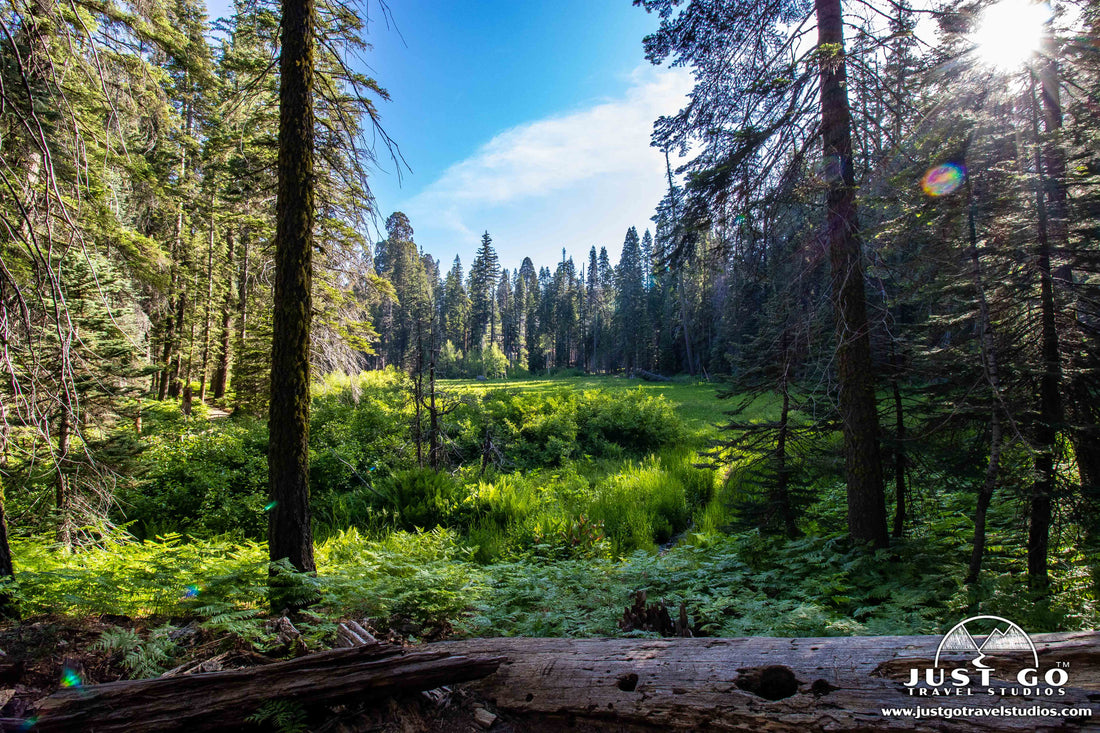When visiting Sequoia National Park, you are likely to expect to be amazed by the towering trees. But what you might not expect is to be immersed in a quiet, peaceful setting like when you hike the Crescent Meadow Trail. This relatively easy trail was one of our favorites in the park, and hiking it early in the morning gave it such a magical feel that it almost left our entire family speechless.
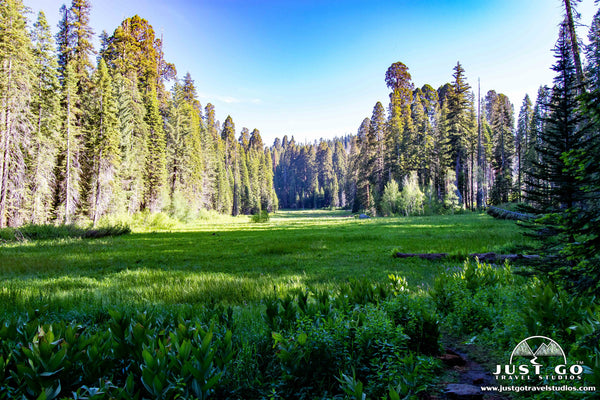
The Crescent Meadow trail is an easy hike that only takes an hour or so to complete. You may, however, become entranced in the scenery (like we did) and want to meander your way through the trail, soaking in all the things around you and just “being” part of the forest. Either way, we bet that when you leave you will love the experience you had.
CRESCENT MEADOW TRAIL DETAILS
- Difficulty: Easy
- Distance: 1.7 miles (round-trip)
- Trail: Loop
- Elevation gain: 160 feet
- Peak elevation reached: 6,810 feet
- Best time of year to hike: Late spring / early summer through fall
- To beat the crowds: Arrive before 7:30 am or after 4:00 pm
- Footwear: Sneakers
- Watch out for: Mosquitoes, bears
- Restrooms: Located at the trailhead, but not on the trail
- Pets: Not allowed
- Time needed: 1 to 1.5 hours
The Crescent Meadow Trail in Sequoia National Park is just one of many things to do in the park. Ahead of your trip, please download a copy of our itinerary for Sequoia National Park, which covers this hike as well as other hikes, gives you an idea on how to spend a 1, 2 or 3 day trip, what to pack and what to do in the area.
PARKING AND TRAILHEAD FOR THE CRESCENT MEADOW TRAIL

Crescent Meadow Trail parking area, courtesy of the National Park Service
The trailhead for Crescent Meadow is easy to get to, but where you can park depends on the season. If you arrive when you are allowed to drive in, you’ll want to get on Crescent Meadow Road, which is reached by going to the Generals Highway (CA-198) and making your way to the Giant Forest Museum. After you get on Crescent Meadow Road, you’ll head to the end of the road, which is about 2.5 miles.
Crescent Meadow Road is typically closed to private vehicles on weekend days (from 8:00 am to 7:00 pm). So, that means that you’ll have to arrive early, or take the shuttle. The shuttle departs from the Giant Forest Museum parking area every 15 minutes and is free.
- Directions from the Giant Forest Museum to the Crescent Meadow Trail (this will take about 5 minutes)
The parking lot for Crescent Meadow is actually quite small and only holds about 50 cars. That may seem like a lot, but this area of the park is quite popular. You may have to wait a bit of time for a spot to open up. Spot open up regularly, but also keep in mind that this is a trailhead for a many other long treks, so cars may be parked there for several days.
Restrooms are available at the trailhead, but there aren’t any on the trail. There is also picnicking near the parking area.
CRESCENT MEADOW TRAIL: TRAIL SURFACE AND ACCESSIBILITY

- Trail surface. The trail out to the meadow is paved, and then turns into packed dirt as you get out a bit further (past the view of the meadow).
- Accessibility. The paved part of the trail may be okay for those not in great physical condition, but there are some small hills which may make it a bit challenging for those in wheelchairs or not sure on their feet.
PREPARATION FOR HIKING THE CRESCENT MEADOW TRAIL
This is a fairly short hike, so there isn’t a ton of preparation required. However, there are a couple things that we recommend bringing with you, just in case:
- Water. Don’t ever forget to bring water with you, and bring more than you think you need. First, the trail is at high altitude, so having staying hydrated is a good way of coping with the lower oxygen levels than you may be used to. Also, you may find that you actually want to spend a bit more time hiking than originally planned and you want to be prepared.
- Shoes. Be sure you are wearing proper footwear. You don’t need hiking boots, but you’ll be on your feet for a bit of time and want to be wearing shoes that you are comfortable in.
- Plan out your route. Normally, hiking trails have a clear path and a set distance. There are a ton of trails / offshoots on this trail, and you will want to be sure you both know what you plan on doing and what options you have if you want to cut your hike short or spend a bit more time exploring.
HIKING THE CRESCENT MEADOW
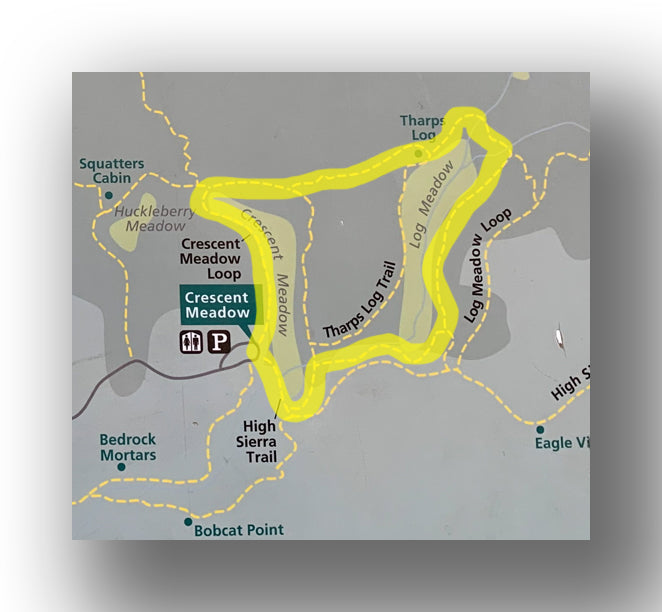
Crescent Meadow Trail map, courtesy of the National Park Service
The trailhead is on the east side of the parking lot and is easy to find. Just be sure you get on the right trail, as the Sugar Pine Trail heads to the south and can be confused with where you actually want to go!
The trail starts off on a paved path, and immediately you are immersed in the tall sequoia trees. There is a slight uphill as you head to the meadow. At the 0.2-mile point, you’ll reach a view of the meadow.
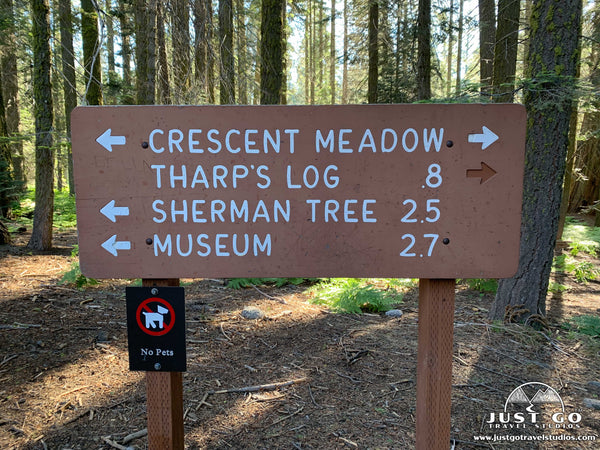
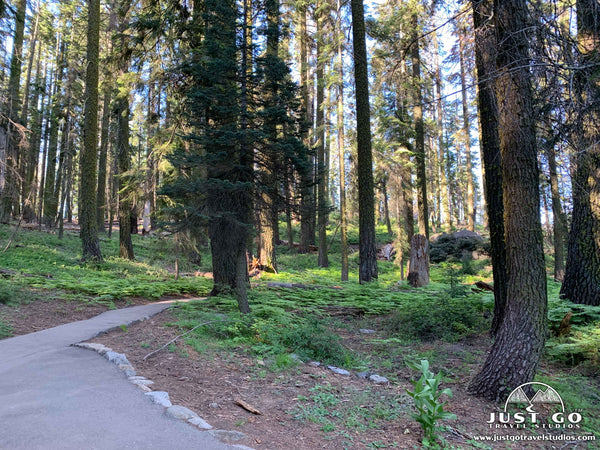
If you limited on time or energy, you can actually turn around here. You’ll get some great photos and see the meadow, but we do recommend you continue on.

From here, the trail continues to the east (which we took) or you can just head north for 0.3 miles to get to the Cleveland Tree. The Cleveland Tree is about 250 feet tall and is the 22nd largest tree in Sequoia National Park.
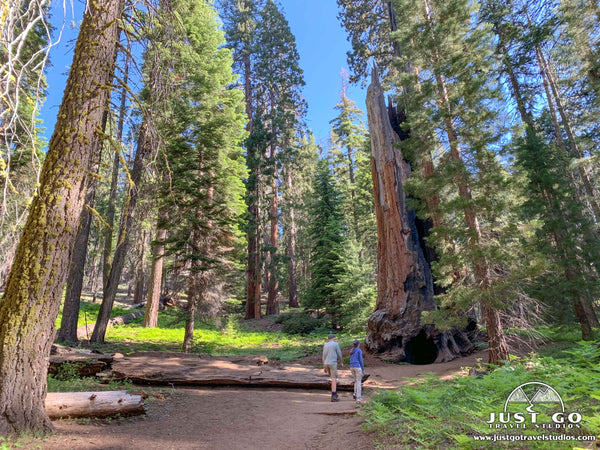
The trail heads up in elevation slightly as it turns to the north. Along the way you’ll have great views of the meadow. You can’t help but walk quietly and softly as you make your way near the meadow. Even our kids were just quiet and awestruck!
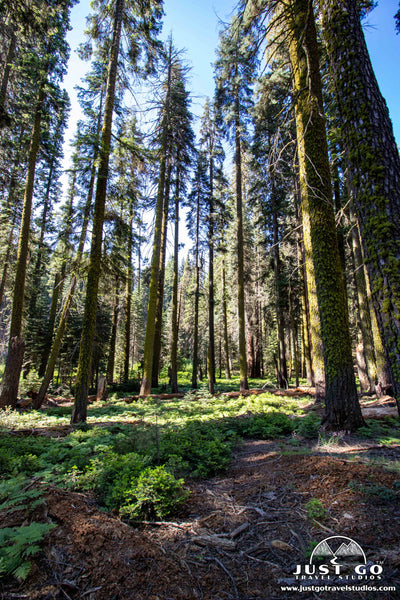
After about 0.5 miles after turning north, you’ll want to take a left (to go west) and head 0.2-miles to Tharp’s Log. Named after the first non-native visitor to the woods (Hale D. Tharp, who first arrived in 1852), the log is hollowed out and was used as a cabin. There is a fireplace and a door. You can walk inside of it too-it was really cool for our kids in particular!

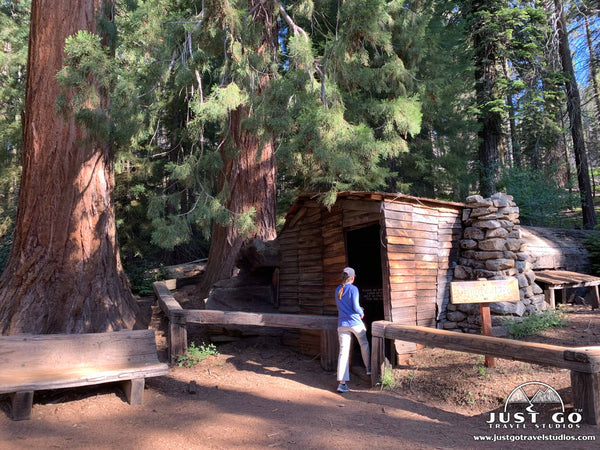
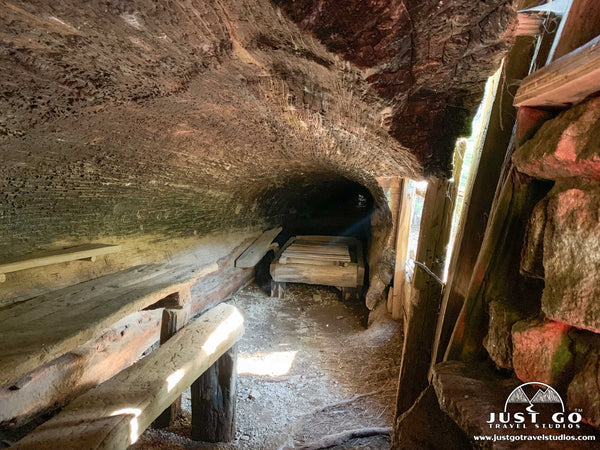
The trail continues west for 0.3 miles before you get to Chimney Tree. This is the remains of a tree that burned in 1914, and you can walk inside of it! It gives you a good window into how resilient the bark of sequoia trees is to fire.
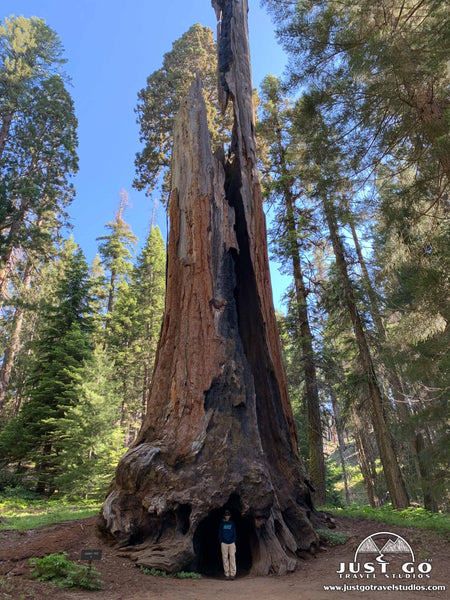
After another 0.3 miles, the trail turns south and heads back to the parking lot while walking along the meadow. Keep your eye out for wildlife when you are on this part of the trail. It was full of deer, and we had to wait for them so we could walk on the trail and not disturb them.
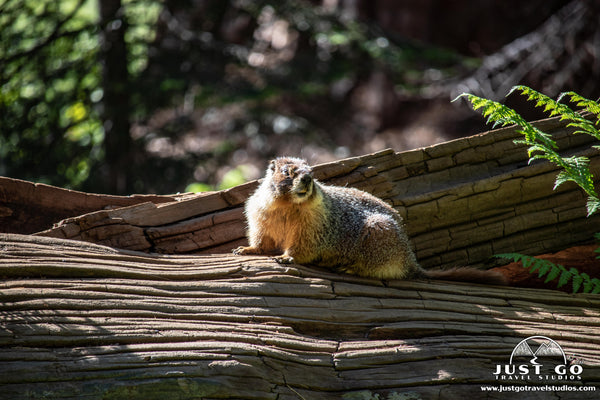

CRESCENT MEADOW TRAIL: TOP LIKES AND DISLIKES
Likes:
- Peaceful Setting. There is no doubt that the National Parks can be crowded. But there is something about this hike that is so special. The meadow just brings out calm (at least it did for us) and we just wanted to relax and look without talking nearly the entire way.
- Additional Trail Options. The hike has so many potential trails from the same trailhead. You can spend hours here exploring on a variety of trails. The further you go, the more you’ll be on your own.
- Plenty of Landmarks to See. From the Cleveland Tree to Tharp’s Log to the Chimney Tree to Crescent Meadow itself, there are almost evenly spaced spots to stop and look around on the trail. It kept our family engaged for the entire hike.
Dislikes:
- Congestion in the Area. We arrived early in the morning to get to this area, but if you aren’t here first thing in the morning, it can be hard to find a spot and can cause some frustration, particularly if you have to extend your time in the area by another 30 min by taking the shuttle after backtracking to the parking area near the museum.
HIKING THE CRESCENT MEADOW TRAIL IN WINTER
The Crescent Meadow Trail can be hiked in winter, but it will take a bit of work. Crescent Meadow Road is not plowed, so you’ll have to hike / snowshoe out to the trailhead before even beginning your hike. This is an amazing space in the winter, though, as you’ll be without crowds. You can also use cross country skis, which you can bring or rent at Waksachi Lodge.
It’s important to note that while you are here in the wintertime that you should be prepared to spend a good 3 or 4 hours getting out to the trail and exploring it, and you’ll need to be prepared. The snow can be very deep and it can get cold, so bring plenty of gear with you.
THINGS TO DO NEAR THE CRESCENT MEADOW TRAIL
The Crescent Meadow Road and Giant Forest Museum area is a great place to spend the better part of the day, if you have the time. Our recommendations in the area include:
- Hike to Moro Rock, which you will pass along the way to Crescent Meadow. This 0.4-mile (round-trip) hike is steep, but very short. It climbs to an amazing viewpoint where you will be able to see Sequoia National Park and the Great Western Divide. If you can handle the stairs up, this is a must-do!
- You can spend a day just hiking the trails that connect to Crescent Meadow. A nice trail is to head north to the General Sherman Tree and the Congress Group. This will add a few miles onto your day, but you can avoid the crowds that take the shuttle to area by walking through the woods instead.
- The Giant Forest Museum is at the entry point to Crescent Meadow Drive, and is a great place to learn about the trees and the area landscape. You won’t need much time here, but we do recommend it!
- The Tunnel Log is located on Crescent Meadow Road, just east of Morro Rock. It’s a fallen tree that you can drive through, which our family loved.
FURTHER INFORMATION ON SEQUOIA NATIONAL PARK FROM JUST GO TRAVEL STUDIOS
- Before you head out, be sure to download a copy of our Sequoia National Park itinerary.
- We have a number of other blogs on Sequoia National Park, including What to See and Do in Sequoia, Sequoia National Park campgrounds, hiking the Tokopah Falls Trail and the Moro Rock Trail. Also check out our blog on the Best Airports for Sequoia National Park.
- If you are visiting Sequoia National Park, then you also should visit nearby Kings Canyon National Park. It is less crowded than Sequoia and has some great hiking.
- When you return from your vacation, let us create a unique vintage-style travel poster from one or more of your photos. This is a unique way of remembering your trips forever!


